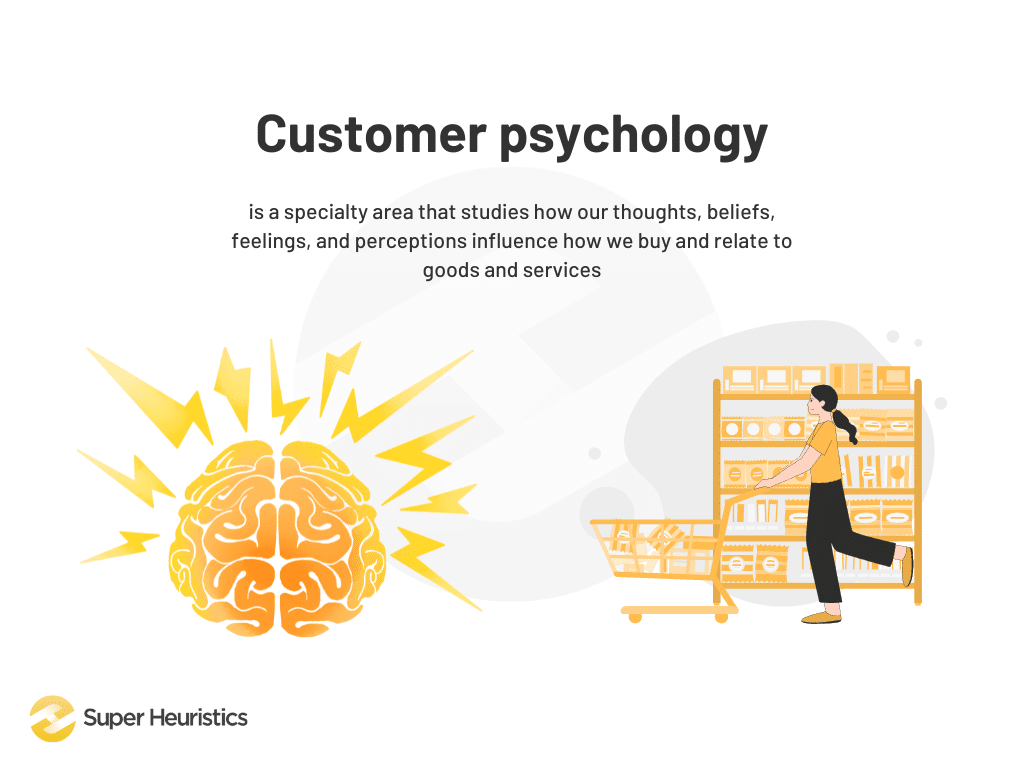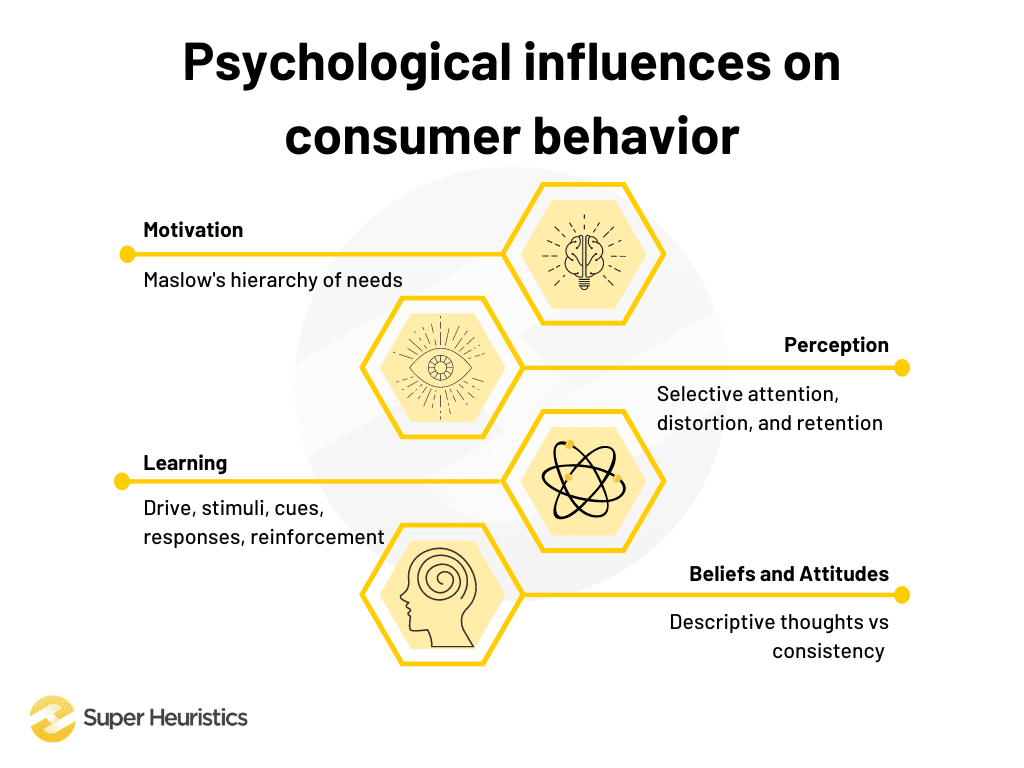‘Psychology’ is defined as “the scientific study of the human mind and its functions, especially those affecting behavior in a given context” by the Oxford Dictionary. It is a well-known fact that marketers use psychology to influence consumer behavior through advertisements, discounts, offers, etc. by analyzing the psychological influences on consumer behavior.
But did you know that a consumer’s psychology also plays an essential role in influencing their consumer behavior?
Let’s take the instant noodles example to understand this better. Recall from the first chapter titled ‘What is Consumer Behavior in Marketing?’ the factors that made you look for your favorite instant noodles. We imagined that you had had a rough, tiring day and were hoping that your mom had cooked something you like for dinner.
When you found that that wasn’t the case, you found the motivation to look for your favorite instant noodles inside the house because you had learned that eating them makes you feel good. After you couldn’t find the instant noodles inside the house, you went to the supermarket.
You saw another brand of instant noodles on the shelf that you didn’t perceive as good enough. You believed that only your favorite brand of instant noodles could cheer you up. So, you bought those and headed home for a relaxing night after a rough day.
Even from the example, however, it is not evident that there are psychological influences on consumer behavior. So, let us look at each of the psychological variables of buying behavior in detail.
Understanding consumer psychology
Consumer psychology or customer psychology is one of the most important terms in this chapter. Let us understand what it means.
Consumer psychology is a specialty area that studies how our thoughts, beliefs, feelings, and perceptions influence how we buy and relate to goods and services. (Very Well Mind)

Marketers need to understand the customer psychology of their target market to plan marketing campaigns that will actually persuade them to buy the product or service. Emotions are the most powerful tool a marketer can use to convince consumers.
The secret ingredient to formulating a successful marketing campaign is to study the psychological influences on consumer behavior.
Let’s take a look at each psychological factor in consumer behavior individually.
Understanding the psychological influences on consumer behavior
Why do marketers even need to study the psychological factors? Why don’t they just put forth the facts and let the consumers decide what they want to do?
In this section, these are the answers I aim to answer.
Emotions are inherent to human beings. Since we are social and political animals, it has also been observed through the psychology of consumption that sometimes groups share a common line of thoughts and emotions. For example, you may notice that your friends have shared opinions about the same brand of instant noodles.
Emotions and beliefs might even help your marketing campaigns so much that consumers may be willing to overlook price or other inhibitors while making a purchase decision. You might have first bought your first packet of your favorite instant noodles just after watching the ads that made you feel something positive about those noodles.
The psychological influences on consumer behavior can broadly be classified under four categories. We’ll go through all these four categories in detail.

1. Motivation
Philip Kotler defines a ‘motive’ as ‘a need that is sufficiently pressing to direct the person to seek satisfaction.’ He defines ‘motivation research’ as ‘qualitative research designed to probe consumers’ hidden, subconscious motivations.’
The Oxford Dictionary defines ‘motivation’ as ‘a reason or reasons for acting or behaving in a particular way.’ So, in the instant noodles example, your main motivation stemmed from the facts that you’d had a bad day, and you were hungry. You were looking to satisfy your safety and physiological needs by consuming instant noodles.
Wait, did we not discuss Maslow’s need hierarchy theory already? We did in ‘Chapter 1 - What is Consumer Behavior in Marketing’! It is an important tool for marketers to advertise their products. The lower you can portray your product on the pyramid, the larger will be its market.

For example, apart from displaying itself as a ‘feel-good product,’ your favorite brand of instant noodles will definitely advertise its product as something that satisfies hunger, which is a physiological needs.
Companies tend to use this strategy because the underlying assumption of Maslow’s theory is that humans move start from the bottom of the pyramid and move in an upward direction.
Philip Kotler had the following remarks about Maslow’s hierarchy of needs:
People are driven by particular needs at particular times.
Human needs are arranged in a hierarchy from most pressing to least pressing.
2. Perception
Philip Kotler defines ‘perception’ as the process by which people select, organize, and interpret information to form a meaningful picture of the world from three perceptual processes:
Selective attention (the tendency for people to screen out most of the information to which they are exposed)
Selective distortion (the tendency for people to interpret information in a way that will support what they already believe)
Selective retention (the tendency to remember good points made about a brand they favor and to forget good points about competing brands)
Taking a look at our instant noodles example again, let us consider an ad campaign publicized by the brand that doesn’t exactly fit your belief system. Since you already love that brand of instant noodles, it is possible that you will filter the information presented in the campaign in such a way that it fits both your and the brand’s beliefs. (selective attention)
It is also possible that you will interpret the information you choose to receive in a way that suits your beliefs and makes you happy. (selective distortion) The most likely of the three points is selective retention, wherein you will only remember the good points of the ad campaign and forgetting the bad ones. (selective retention)
3. Learning
According to Philip Kotler, ‘learning’ refers to the changes in an individual’s behavior arising from experience and occurs through interplay of:
Drives
Stimuli
Cues
Responses
Reinforcement
A drive can be defined as ‘an innate, biologically determined urge to attain a goal or satisfy a need.’ So, your drive for buying your favorite brand of instant noodles in our example is hunger and psychological tiredness.
Stimulus is ‘a thing that arouses activity or energy in someone or something; a spur or incentive.’ Your main stimulus for choosing to buy the same brand of instant noodles as always is the innate pleasure you receive by eating it.
Stimuli can be both internal and external. While internal stimuli include thirst and hunger, external stimuli include advertisements, offers, word-of-mouth, etc.
Cues are the stimuli that suggest a specific way to satisfy your motivations. Your cue to repeat purchase can be the advertisements you see on television or the happiness you want to experience by repeating purchase.
A response is the consumer’s reaction to a cue. Consumers rely heavily on their previous experiences with the product or service to decide their response. Your response to the cue is going to the supermarket to repeat your purchase of the instant noodles.
The last factor is reinforcement. Reinforcement is ‘the reward - the pleasure, enjoyment and benefits - that the consumer receives after buying and using a product or service.’ Your reinforcement is the gratification you receive from consuming your favorite brand of instant noodles.
These five factors make up one of the most important psychological influences on consumer behavior, called learning.
4. Beliefs and attitudes
Philip Kotler defines ‘belief’ as a descriptive thought that a person has about something based on:
Knowledge
Opinion
Faith
Since you are a responsible consumer, you obviously don’t only depend on advertisements and offers to incentivise you to repeat your purchases. You must also depend on knowledge you have about your favorite brand of instant noodles, which might include nutritional information, sustainability of packaging, etc.
You would also hold an opinion that this specific brand of instant noodles is better than its alternatives because of the price point, portion, packaging, etc. You also have faith that this brand of instant noodles will fulfill your needs the next time you purchase it just as well as it did the last time.
According to Kotler, attitudes describe a person’s relatively consistent evaluations, feelings, and tendencies toward an object or idea.
Your attitude toward your favorite brand of instant noodles is inherently positive. You associate positive feelings with it because you know it can cure you of a bad day. You consistently prefer the same brand of instant noodles over others.
Conclusion and key takeaways
We are through with studying the psychological influences on consumer behavior. Let’s recall some of our key takeaways:
- Consumer psychology is a specialty area that studies how our thoughts, beliefs, feelings, and perceptions influence how we buy and relate to goods and services.
- Philip Kotler defines a ‘motive’ as ‘a need that is sufficiently pressing to direct the person to seek satisfaction.’ He defines ‘motivation research’ as ‘qualitative research designed to probe consumers’ hidden, subconscious motivations.’
- Philip Kotler defines ‘perception’ as the process by which people select, organize, and interpret information to form a meaningful picture of the world from three perceptual processes, namely selective attention, selective distortion, and selective retention.
- According to Philip Kotler, ‘learning’ refers to the changes in an individual’s behavior arising from experience and occurs through interplay of drives, stimuli, cues, responses, and reinforcement.
- Philip Kotler defines ‘belief’ as a descriptive thought that a person has about something based on knowledge, opinion, and faith.
- According to Kotler, attitudes describe a person’s relatively consistent evaluations, feelings, and tendencies toward an object or idea.
In the next chapter, we will study the types of buying decision behavior.

